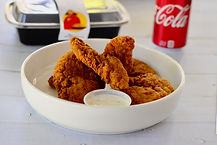
How to Feed Your Family
By Megan Moini, MD

As a pediatrician, one of my most important jobs is helping kids create healthy eating habits. Like Mr. Dr. Moini and Dr. Nelson, I'm also an internist that helps adults try to undo healthy habits they've learned during childhood, or developed on the path to adulthood. I've come up with a list of Do's and Don'ts that I recommend all parents consider when feeding their kids. Now, as a parent, I acknowledge that no one is perfect, and we all make mistakes including doing things found on the "Don't" list from time to time. As is the theme of HealthierLifeMD, perfection is not the goal, but rather practicing healthy habits 90% of the time.
Many people become motivated to live healthier after they have children. Other people focus on their kid's health but sacrifice their own. We all want to be around for our kids, and maybe one day be able to run around with our grandkids. Let's use whatever motivates you to help you get your whole family on track to long-term health!

As a note, this is general advice for typically developing children. Always talk to your doctor if you have concerns or questions about your child's health.
We'll start with the top 10 Do's and Don'ts to get you started. As you progress in your journey towards a healthier life, we'll talk more about feeding challenges and recommendations for specific age groups. I'm active in the forum and look forward to hearing from you!
- Megan Moini, physician and mom
Feeding Your Kid:
Top 10 Do's and Don'ts
1) DO normalize healthy foods.
Make eating healthy foods a normal part of life. In general, every meal should include a fruit or vegetable. Giving variety helps your children be familiar with different foods, increasing the chances that they will be comfortable eating them. Contrast that with, "Brianna, do you want to try this...broccoli?!" Kids are way better at reading facial expressions than adults, and now Brianna is learning that there's a reason to be very wary of broccoli.

2) DON'T try to control how much kids eat.
This is HUGE. And a big contributor to adults losing their ability to self-regulate their hunger and appetite. Children are, with few exceptions, VERY good at knowing when they're hungry and not hungry. We all listen when they tell us they're hungry - we all want the screaming to stop. But when kids tell us they're not hungry, we negotiate, we beg, we plead...all based on what we think is an appropriate amount of food. "Take three more bites..." "Finish your plate!" Kids need to listen to their body's cues about hunger and fullness. When we force them to eat what we think they should be eating, we're teaching them not to trust their body's cues, and to look for outside sources to guide portion size. Enter, every food manufacturer that markets heavily to children and teens. Inability to sense fullness can predispose to overeating, and ultimately, obesity.

3) DO offer unprocessed snacks; DON'T offer unhealthy drinks.
Speaking of marketing, companies do a really good job telling us that Goldfish crackers, yogurt pouches, and "juices" are healthy kids snacks. But they're all processed and/or full of unnecessary added sugar. Snacks like fruit, cheese, and nuts are healthy (provided allergies aren't an issue) and they provide much better macro- and micronutrients than the products marketed as "kid snacks." For drinks, your child should have mostly water, no more than two cups of milk daily, and rarely anything else. Too much milk can cause anemia and fill up your kid so he or she doesn't eat actual food. Juice, soda, and "kid smoothies" are just full of sugar and are of minimal to no nutritional value.

4) DON'T think that kids are meant to live on chicken nuggets and butter noodles.
Have you noticed that every restaurant, whether it’s American or Chinese or Mexican, has the same kids menu? It's some combination of chicken nuggets, cheese pizza, and buttered noodles. Come on, Americans, we’re better than this! There is no innate need for small children to eat a diet based on chicken nuggets – children that grow up in Japan or France or Argentina certainly aren't. A wise pediatrician once said, “Hungry children don’t throw food.” If you’re hungry and you’re sitting at a table with unfamiliar foods in front of you, you’re going to try some…UNLESS you know if you whine enough you’re going to get a special order of butter noodles…but that’s another story. Fun fact: there’s a medical diagnosis called toddler’s diarrhea, it’s chronic diarrhea caused by a poor diet of processed, simple carbs, without enough fiber or nutrients. Now, if your child is currently on a very limited diet, don't fret...it's not too late to start introducing new things. Exposure is key. The more kids are exposed to, the more likely they will try, and the wider their palate. Even though the process can be painful, changing food habits is a lot easier in a toddler than a 10 year old.

5) DO teach your children about healthy food.
This should start early. My 5 year old knows some foods have protein in them, which he needs to grow big muscles. My 3 year old knows that we don't eat too much ice cream because too much is not healthy for our bodies. Start with the basics, as you're learning them. Avoid discussion of calories until middle or high school age, when you can begin to talk about "calorie-dense" foods, and even then, tread carefully (see #7).
6) DON'T use terms like "good foods" and "bad foods."
Yes, I think some "food" is processed garbage that no longer resembles any food (I’m looking at you, Cheetos!). BUT it’s more helpful to teach about healthy vs not healthy. Your kids will be exposed to these unhealthy foods at school, birthday parties, and their friends' houses. Making something forbidden just increases the appeal, possibly leading to later rebellion, sneaking food, or worse, making your kids feel guilty about eating certain foods. We want eating to be a positive experience; creating shame around food can lead to eating disorders, depression, and anxiety that your child may battle for life. And we all want to make our children as healthy and happy as possible so they can have as easy a life as possible, right?

7) DON'T discuss weight.
Speaking of eating disorders, the best way to give your child an eating disorder is to discuss weight, either yours or theirs. This goes for girls AND boys. ALWAYS focus on health and positive body image. Saying negative things about your own body, looking in the mirror and pinching your excess skin with a frown on your face can be very confusing to kids...it tends to make them look at their own body and wonder what is wrong with it that they never noticed before. For families working on helping their child become healthier, it’s great to point out the positive, “Wow, look how strong you are!” “You ran the whole way, that was fast!” People often create this magical number in their heads where they think at that weight, they’ll be happy. Why? The number doesn’t matter as much as your health – do you have energy? Can you do the things you want to do? Those are the things that matter, the things we can control with making healthy choices, and the things we want to share with our kids, instead of numbers on a scale. If you think your child is developing a negative body image, restricting food, or is overly concerned about their weight, talk to his or her pediatrician ASAP.
8) DO have family meals as much as possible.
Family meals are a great time to expose your kids to increasing variety. I'm that mom that says, "If you don’t try it, you don’t know if you like it!" I often tell my kids that’s like saying I hate that song, when I’ve never even heard it! Maybe it’s going to be my favorite song ever! One helpful trick while you’re working on expanding your kid’s palate is to include one thing you know they’re going to eat with each meal. That way, you won’t stress that they’re not going to eat anything. Usually once kids start eating, they’ll keep sampling the other things on their plate. If they don’t eat it, they’re obviously not hungry. If they come back later complaining they’re hungry, have their plate available to revisit. Besides increasing the variety of foods in your child's diet, family meals are a great time to bond, away from screens and other distractions. Often when sitting together without distraction, kids will open up about their day and let you in on what's really going on in their lives. Depending on your schedules, it may not be possible to sit down together every night, but trying to make it a priority when possible is key.

9) DON'T make foods rewards.
Eating delicious foods, particularly calorie-dense foods like French fries and ice cream, activates the reward circuit in our brains. When you use these foods as a reward, this can hype the reward circuit into overdrive. Not only does it taste delicious, but I know when I get ice cream it’s because I was a good girl. The super positive association and good feelings surrounding ice cream stays with us, and can lead to overeating and obesity in the future. How? We keep chasing that feeling. Bad day? I’ll eat a pint of ice cream to feel better. (This conversation is primarily happening in our subconscious mind.) This is one of the reasons pediatrician offices no longer have lollipops as a reward (that and we don't want to be responsible for rotting your kids' teeth!) I’m not saying don’t take your kids out for ice cream, just don’t use the ice cream as a reward for being good at the doctor’s office.
10) DO teach your children how to cook.
Want to give your kid a big leg-up to becoming a healthy, competent adult? Teach him or her how to cook some meals. If you’re not a great cook, there are many ways you can learn together – watch Chef Doug Katz's videos together, sign up for a cooking class, or browse the internet to make your favorite dishes. Unless they’re going to culinary school, no one in college or at work is going to be instructing your kids on food prep – it’s yet another one of our jobs as parents. And it doesn’t have to be anything fancy…a good goal is proficiency at 5-10 basic meals. If your child can steam some veggies, bake chicken, make a pasta dish, cook rice, etc…they’re good to go out into the real world. They’re smart and capable; they can take it from there.

Stay tuned for more tips on how to feed your family from Dr. Megan Moini.
